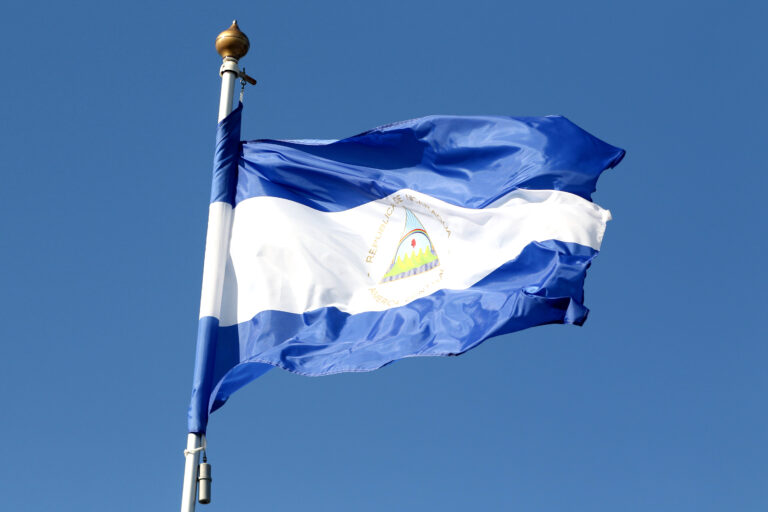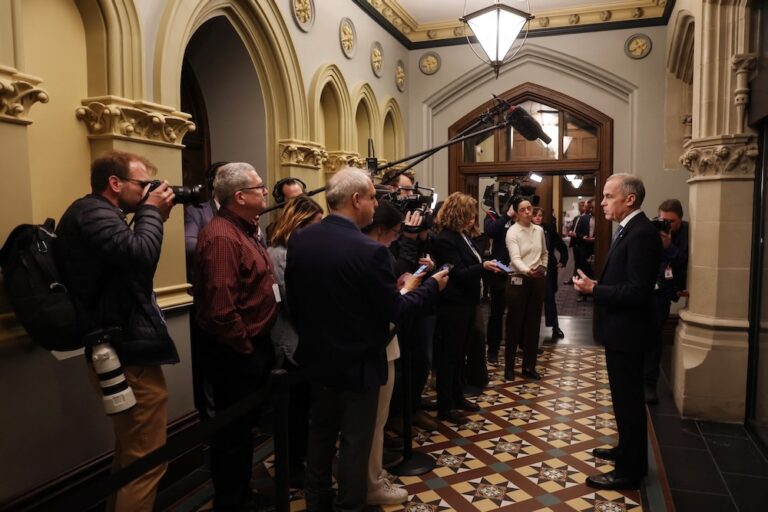In her contribution to IFEX's series marking International Women's Day, Regional Editor Paula Martins writes about the attacks against Brazilian journalist Patrícia Campos Mello - another troubling example of how gender discrimination is used to damage the credibility of women reporters and the legitimacy of their reporting.
Patrícia’s story
“In societies where women have to fight to have control over their own bodies, have to fight to reassert their right in the public space – being a woman journalist is almost a form of activism.” — Egyptian journalist Rawya Rageh
Rageh was commenting at the launch of the Committee to Protect Journalists’ 2016 edition of their Attacks on the Press series – an edition that highlighted gender-based online harassment, sexual violence, and physical assault experienced by women journalists.
People who know of the recent work of Brazilian investigative journalist Patrícia Campos Mello – and how she has been targeted for it – would agree with Rageh.
On 11 February 2020, Brazilians were watching a live broadcast of a Brazilian Congress investigation into the use of ‘fake news’ during electoral campaigns. Under scrutiny was a scheme that featured the illegal use of IDs and the dissemination of disinformation. It had been been exposed by Campos Mello.
A witness was being questioned about the massive remittance of WhatsApp messages by the campaign of then-candidate Jair Bolsonaro during the run up to the 2018 presidential elections. The witness – a former employee at one of the companies accused of providing the illegal services – said that Campos Mello had offered sexual favours in exchange for information.
Patrícia Campos Mello is a reporter at Folha de Sao Paulo, Brazil’s largest newspaper. She covers important issues in Brazil and abroad, including humanitarian and human rights news. In 2019 she received CPJ’s International Press Freedom Award, adding to the King of Spain Journalism Prize, the Petrobras Prize in 2018 and the Red Cross International Committee Prize for humanitarian journalism in 2017. This was clearly an attempt to discredit her reporting.
Campos Mello and her newspaper circulated the original messages that had been exchanged between her and the witness. Then-Congressmen Bolsonaro and two others tweeted accusations supporting the witness. A day later, the president of Brazil himself reaffirmed the unfounded accusations in an interview. He even tried to joke about it, using words with double meanings that added a sexual connotation to his remarks.
This was not the first time Campos Mello had been targeted online by Bolsonaro’s supporters. Immediately after publishing her piece she had been subjected to serious threats and online abuse. And despite the outcry and extensive public support she received nationally and internationally, many, especially via social media, continued to express doubts about her work. Spreading disinformation is easier than countering it.
It was an attack on two fronts. She was attacked as a woman. And she was attacked as a journalist.
Her case is yet another troubling example of how gender discrimination is used to damage the credibility of women reporters, and how their personal lives can be weaponized to undermine the legitimacy of their reporting.
Double vulnerability, specific challenges
It is a global issue. Women journalists around the world face specific obstacles due to their gender – from discrimination to harassment, from threats to physical and psychological attacks, both online and offline.
As stated by CEDAW, violence against women is broadly defined as “any distinction, exclusion or restriction made on the basis of sex which has the effect or purpose of impairing or nullifying the recognition, enjoyment or exercise by women, irrespective of their marital status, on a basis of equality of men and women, of human rights and fundamental freedoms in the political, economic, social, cultural, civil or any other field”.
It remains a powerful obstacle to women’s exercise of their right to freedom of expression.
According to the UN, gender-based violence against women journalists has been on the rise, including the number of women journalists killed – in the period from 2014 through 2018, UNESCO denounced the killings of 46 female journalists.
The numbers are growing, but less than 10% of journalists killed are women. This is probably because fewer women report on conflicts, organised crime, and government corruption – the highest-risk beats.
When they do cover such issues, violent sexual assaults such as those suffered by Lara Logan and Jineth Bedoya tell the tale. Sexual violence is an especially cruel and effective tool in the arsenal used to silence women journalists.
Dirty little secrets
Reporting on sexual assault has been increasing, but many women journalists refuse to disclose what happened to them. They fear they will be seen as weak by their male colleagues, and they fear retribution. In some cases, they do not report out of a misplaced sense of shame.
Sexual assault and harassment within the media industry have been recognized as a critical problem for decades – in the field and in newsrooms. According to Kim Barker, a New York Times reporter who has written on her experiences of sexual harassment in the field – and been the target of trolls afterwards – “it was almost like this dirty little secret, you didn’t talk about it… because you had to seem like you were just like one of the guys.”
Online / Offline / All the time
“The Troll Patrol Project documented 1.1 million problematic or abusive attacks against 778 monitored women journalists and women in politics during the period of one year – on average, one message every 30 seconds.”
Women may have a lower profile among murdered journalists, but they are disproportionately represented among the victims of online harassment. The expansion in the use of ICTs, and of the internet in particular, has been both an opportunity and a curse for women journalists. Studies show that female journalists are targeted more frequently and more viciously by online abuse and harassment than their male colleagues.
According to the UN Special Rapporteur on Violence Against Women, “[the digital era] has also provided a platform for new forms of online violence including cyberstalking, defamation campaigns, “doxing”, “sextortion” and “trolling”, as well as the non-consensual distribution of intimate content (or “revenge porn”)”.
Amnesty International and Element IE’s Troll Patrol Project cast a light on the dimensions of the problem; they documented 1.1 million problematic or abusive attacks against 778 monitored women journalists and women in politics during the period of one year – on average, one message every 30 seconds. “Women of colour were more likely to be impacted – with black women disproportionately targeted with problematic or abusive tweets”.
A recent survey by CPJ shows that online harassment is already the biggest safety concern facing many female journalists (90% in the US and 71% in Canada) – “The threats follow us home”, they affirm. As per a study by Trollbusters and the International Women’s Media Foundation, approximately 30% of the women journalists interviewed said they had considered leaving the profession as a result of the online abuse they suffered.
It is important to remember that online and offline violence feed into each other. As highlighted by the Broadband Commission for Digital Development, “[a]buse may be confined to networked technologies or may be supplemented by offline harassment including vandalism, phone calls and physical assault. Similarly, the viral character of distribution is now explosive. What was once a private affair can now be instantly broadcast to billions of people across the digital world”.
The untold stories
“Women journalists have the right to practice journalism free from discrimination and gender-based violence. We all have the right to listen to what they have to say. Let’s stand together and demand: “Enough!”
Freedom of expression activists and experts like to say that when one journalist is silenced, he is not the only victim. Society’s right to information is violated.
How much is society suffering from the hundreds of women journalists silenced every year, across the globe? What is not being said? What is not being covered?
As highlighted by IWMF, when reporting is dominated by men, so is content. Violence against women journalists can result in the invisibilization of crucial issues of specific relevance to women, such as gender equality, sexual and reproductive rights, women in politics, and violence against women.
But the absence of women’s voices can negatively impact how all issues are reported on. Consider the recent case of the murder of Ingrid Escamilla in Mexico. The brutality of the crime was covered by some newspapers with shocking frontpage pictures of her skinned body, revictimizing her, vulgarizing the crime against her and normalizing the broader issue of violence against women – in a country where 14,558 women were raped in 2018.
A study looking at media coverage in 114 countries pointed out that only 9% of news in print, radio and television evoke gender (in)equality issues and only 4% of the stories clearly challenge gender stereotypes. Only 1 in 4 people heard or read about in the news are women.
Would newsrooms with more women result in different coverage? It would help. But we also need more women in decision-making roles. Men still occupy 73% of top media management positions.
Striking back
Colombian journalist Jineth Bedoya Lima was kidnapped at the gates of La Modelo prison in Bogotá in 2000, tortured and raped for her coverage of crime and trafficking. She says that she first saw herself “as a victim, then as a survivor, and now as an activist defending the rights of women.”
Jineth waited 19 years to see her violators sentenced. Actually, she did not wait, she fought for 19 years, for her case and for the cases of hundreds of other women.
Her case was successfully taken to the Inter-American Commission on Human Rights and to the Inter-American Court in 2019. And they were clear – Colombia should take measures to prevent cases such as Jineth’s from ever taking place again.
Bedoya’s case highlights the importance of international bodies in holding states accountable for the safety of women journalists. The Commission indicated the need for training programs for public servants, security forces, and justice authorities, to ensure they have the skills needed to identify gender-based acts and the manifestations of violence against women that affect female journalists. It also recommended measures to raise public awareness about gender-based acts of violence against women journalists, in order to address the full consequences of the violations, including both “material and immaterial losses”.
Other important developments at the international level – the UN Secretary General’s report on the safety of women journalists in 2017, the resulting UN General Assembly resolution, as well as similar resolutions by the Council of Europe – point to a growing recognition of the challenges faced by women journalists and the need for institutional commitments to change the situation.
All of this points to a path to turn this situation around. But it is important to remember that violence against women journalists is part of a broader pattern of discrimination in the region, one based on factors including race, ethnicity, religion or belief, age, class, sexual orientation, and gender identity. In 2018, the OAS Special Rapporteur on Freedom of Expression dedicated a full report to this issue. Any solutions, therefore, call for a holistic approach, broad societal awareness, and institutional commitment.
Women journalists have the right to practice journalism free from discrimination and gender-based violence. We all have the right to listen to what they have to say. Let’s stand together and demand: “Enough!”



